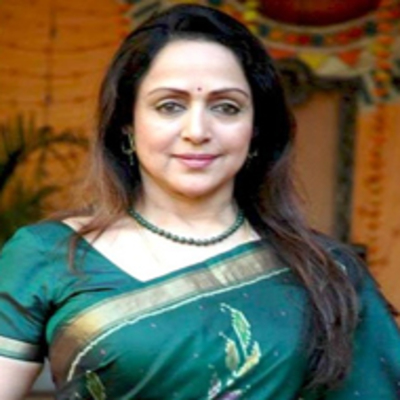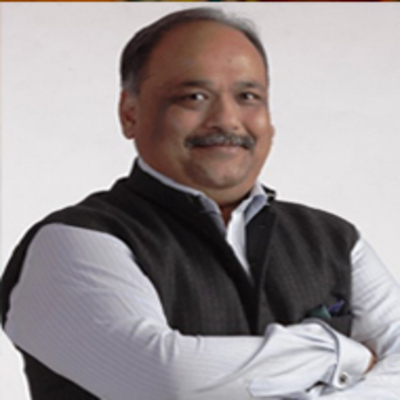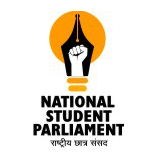Inauguration
Inagural Session 10.30 am -11.00 am

Hema Malini
Actor

Ajay Sancheti
Member of Rajya Sabha
Sessions I
Schedule : 22nd January 2021 11:30 am - 1:00 pm
Title : Papa Kehte Hai Bada Naam Karega” ( पापा केहते हैं बडा नाम करेगा)
Day-1
- Mr. Ram Bhogale
- Prof. Parimal Merchant(Moderator of the session)
- Mr. Hanmant Ramdas Gaikwad
- Mr. Manish Maloji Patil
The session aspires to infuse the spirit of entrepreneurship within the young participants. We want to stimulate and inspire our Gen X participants to relay forward the torch of their family owned business and be “Atmanirbhar” in the true sense of the term.
The session will be focusing on inculcating, developing and polishing of entrepreneurial skills needed to establish and run his / her enterprise.
The speakers will share their journey- achievements, challenges faced by them, real life examples and will also guide them about how to become a successful entrepreneur. The valuable guidance of the eminent speakers will help students stride stronger.
Sessions II
Schedule : 22nd January 2021
Title : Woman Empowerment - Leadership in the Indian Politics
Day-1
- Medha Kulkarni
- Jyotsana Ekbote
- Sachin Sawant
- Vidya Chavan
- Anees Chishti
- Shivang Mathur (Moderator)
Sessions III
Schedule : 23rd January 2021
Title : Life in 2030… 10 Crucial Years ahead…
Day-2
- Amrut Bang
- Sunil Gupta
- Prakash Amte
- Mr. Kunal Joshi
- Rashid Hashmi (Moderator)
It all started centuries back when the thoughts and ideas of people who lived hundreds of years ago became true with the help of Science.
As per the article written by Mark Oliver and studies carried out throughout the globe, it is projected that a lot will change in the next 10 years. Over the past decade, we’ve seen the start of a new race to Mars, the commercial release of self-driving cars, and the first photograph of a black hole. And over the next ten years, the changes are going to be even more incredible. People who lived over thousand year ago predicted many things that was proved true by the scientists. Evolution of human being, the big bang theory and many more. What was the technology and source of knowledge they possessed is still a big question. Probably those predictions were all scientific forecasts that led to actual discoveries and inventions.
Experts and researchers have predicted a lot of revolutions in the upcoming 10 years. Till 2030 we may visualize a number of technology innovations and developments for us. We may see a fully electric commercial aircraft for shorter domestic flights, flying cars can also be seen on roads and in the air, autonomous vehicles, almost the entire population connected to internet, etc. The development phase will start from 2020-21 with the use of Artificial Intelligence and Data Sciences helping inventors create the mind-reading machines followed by solar powered automobiles and aircrafts. The mouse and keyboards will be replaced by user interfaces bringing about a revolution in the hardware side of computing. The construction companies will use computerized equipment to enhance productivity with reduced costs. Wrist watches are already in market replacing smartphones, the additive, mystic augmented lifestyle will be the future through internet and gadgets. It is predicted that Internet of things will be in boom by 2024. Autonomous passenger drones can also get conceptualized by this years and these drones will transform the police functioning.
2025 will commence in a number of technology breakthroughs. Artificial intelligence will be at its boom with wearable augmented reality glasses replacing smartphones. 5G will be fully operational. Learning and acquiring skills will be made easier through brain-reading wearable devices. India being an agricultural economy, devices such as drones and smart machines will be used making agriculture a lucrative business. 70% of the transport is predicted to be battery operated. The data scientists will create a state-of-art super computer by 2027. Nanotechnology will be fully developed by 2028 with the technology creating the future of medicine. Scientists may develop a technology to predict heart attacks and even find ways to fix human brains. The doctors along with scientists may study and invent a methodology to reverse ageing of human heart. By 2028, the scientists may begin reviving extinct species. We may also see the first manned mission to Mars during these years.
It has been predicted that there may be an economy slowdown in 2024 with global crash of economy. Still those nations that will continue to indigenously workout with optimum resource utilization and export of their commodities globally shall survive. This phase will be an opportunity for the developing nations to consolidate and enrich their economy and this will be visible to be highly successful for the developing nations to overtake the economy of developed nations by 2028. This year will see the crisis point of maximum population globally and hence nations will need to properly plan out for this crisis.
The world is moving towards a wireless electricity mode with the help of innovations. Each of us need to be innovative and keep pace with this challenging and exciting decade of 2020-2030 and be prepared for the Life in 2030…
Sessions IV
Schedule : 23rd January 2021 2:30pm – 4:00 pm
Title : News Channels – Breaking Rules to give Breaking News
Day-2
- Shivani Gupta
- Ravindra Ambekar
- Prema Sridevi
- Savio Rodrigues
It is undeniable that television has become the most powerful media with unprecedented influence over the minds of the people. TV channels have the power to set the country afire with their hateful discourse, for which some of them have become notorious. Everyone can see freedom of speech being blatantly abused on a daily basis.
Unbridled power is always dangerous. Some checks and regulations are obviously required. What are the possible forms of such regulation? They are government regulation, self-regulation and independent regulation
Media in India is mostly self-regulated. The existing bodies for regulation of media such as the Press Council of India which is a statutory body and the News Broadcasting Standards Authority, a self-regulatory organization, issue standards which are more in the nature of guidelines.
The Supreme Court of India came down heavily on a TV channel that was intent on broadcasting hate-filled programmes. The Court underlined the need for laying down clear guidelines, and their effective implementation, for the media against hate speech. This has brought to the centre-stage, once again, the debate about the need, scope and extent of media regulation.
The government has made several attempts in the past to regulate the media but all such attempts came crashing down in the wake of public outcry. The last such attempt was in April 2018 when the Information and Broadcasting Ministry issued a circular stipulating that the accreditation of a journalist found to have “created and/or propagated” fake news will be suspended or permanently cancelled.
Government regulations are, of course, not desirable as these could interfere with the freedom of speech and expression enshrined in the Constitution (Article 19), though it is pertinent to remember that the same Article also provides for “reasonable restrictions” on this freedom.
Sessions V
Schedule : 23rd January 2021 3:00 pm - 5:00 pm
Title : News Channels – Breaking Rules to give Breaking News
Day-2
- General V P Malik (retd),Former Army Chief.
- Air Chief Marshal P V Naik (retd.), Former IAF Chief
- Admiral Sunil Lanba (retd), Former Navy Chief
- Marshal P V Naik (retd) & Current Chairman- National Maritime Foundation.
- Ashish Singh (Moderator)
- Army Chief Gen Manoj Mukund Naravane(Chief Guest)
On 1 April, 1950, India became the first non-socialist bloc country to establish diplomatic relations with the People’s Republic of China. Prime Minister Nehru visited China in October 1954. While, the India-China border conflict in 1962 was a serious setback to ties, Prime Minister Rajiv Gandhi’s landmark visit in 1988 began a phase of improvement in bilateral relations. In 1993, the signing of an Agreement on the Maintenance of Peace and Tranquility along the Line of Actual Control (LAC) on the India-China Border Areas during Prime Minister Narasimha Rao’s visit reflected the growing stability and substance in bilateral ties.
Cumulative outcomes of the recent high level visits have been transformational for our ties. During Prime Minister Atal Bihari Vajpayee’s visit in 2003, India and China signed a Declaration on Principles for Relations and Comprehensive Cooperation and also mutually decided to appoint Special Representatives (SRs) to explore the framework of a boundary settlement from the political perspective. During the April 2005 visit of Premier Wen Jiabao, the two sides established a Strategic and Cooperative Partnership for Peace and Prosperity, while the signing of an agreement on Political Parameters and Guiding Principles, signaled the successful conclusion of the first phase of SR Talks.During the State Visit of Chinese President Mr. Xi Jinping to India from 17 to 19 September 2014, a total of 16 agreements were signed in various sectors including, commerce & trade, railways, space -cooperation, pharmaceuticals, audio-visual coproduction, culture, establishment of industrial parks, sister-city arrangements etc. The two sides also signed a MoU to open an additional route for Kailash Mansarovar Yatra through Nathu La. The Chinese side agreed to establish two Chinese Industrial Parks in India and expressed their intention to enhance Chinese investment in India.
Prime Minister Narendra Modi visited China from May 14-16, 2015. Besides meeting with the Chinese leadership, Prime Minister Modi and Premier Li also addressed the opening session of the First State/Provincial Leaders’ Forum in Beijing. There were 24 agreements signed on the government -to-government side, 26 MoUs on the businessto-business side and two joint statements, including one on climate change. Prime Minister also announced the extension of the e-visa facility to Chinese nationals wishing to travel to India.
The momentum of meetings at the leadership level continued in 2016 too. President Pranab Mukherjee made a state visit to China from May 24 to 27, 2016. He visited Guangdong and Beijing where he met with the Chinese leadership. President also delivered a keynote address at the Peking University and attended a Round Table between Vice Chancellors and Heads of institutions of higher learning of the two countries. Ten MoUs providing for enhanced faculty and student exchanges as well as collaboration in research and innovation were concluded between the higher education institutions of the two countries. Prime Minister Narendra Modi visited China in September 2016 to participate in the G20 Summit in Hangzhou and September 2017 to participate in the BRICS Summit in Xiamen, where he also held bilateral talks with President Xi Jinping. President Xi Jinping visited India in October 2016 to participate in the BRICS Summit in Goa. The two leaders also met along the sidelines of the SCO Heads of States Summit in Tashkent in June 2016 and in Astana in June 2017.
India and China have established more than thirty dialogue mechanisms at various levels, covering bilateral political, economic, consular issues as well as dialogues on international and regional issues. The Foreign Ministers have been meeting regularly.
Chinese Foreign Minister Wang Yi travelled to India from 12-14 August, 2016 during which he met with EAM and called on Prime Minister. The mechanism of Special Representatives on the Boundary Question was established in 2003. The 19th round of talks between Shri Ajit Doval, National Security Advisor and Mr. Yang Jiechi, State Councillor was held in Beijing in April, 2016. State Councillor Yang Jiechi also visited India in November 2016 where he met with NSA for informal strategic consultations. The 1st reconstituted Strategic Dialogue between Foreign Secretary, Mr. S Jaishankar and the Chinese Executive Vice Foreign Minister Mr. Zhang Yesui was held in February 2017. India and China have also established a High Level Dialogue Mechanism on Counter Terrorism and Security, led by Mr. R.N. Ravi, Chairman (JIC) and Mr. Wang Yongqing, Secretary General of the Central Political and Legal Affairs Commission of China. The first meeting of the mechanism was held in Beijing in September 2016. To facilitate high level
exchanges of Party leaders from China and State Chief Ministers from India, a special arrangement has been entered into by the International Liaison Department of the Central Committee of the Communist Party of China and the Ministry of External Affairs (MEA-IDCPC) since 2004. There are regular Party-to-Party exchanges between the Communist Party of China and political parties in India. In order to facilitate exchanges between Indian states and Chinese provinces, the two sides have also established a States/Provincial Leaders Forum.
The Trade and Economic Relationship between India and China has seen a rapid growth in the last few years. India-China cultural exchanges date back to many centuries and there is some evidence that conceptual and linguistic exchanges existed in 1500-1000 B.C. between the Shang-Zhou civilization and the ancient Vedic civilization. Apart from this, Chinese students are also annually awarded scholarships to study Hindi at the Kendriya Hindi Sansthan, Agra to learn Hindi. For the year 2017-18, 5 Chinese students have been selected to study in Agra under this scheme.
All these aspects affect India’s Defense, Strategy & Security in regard to china.


